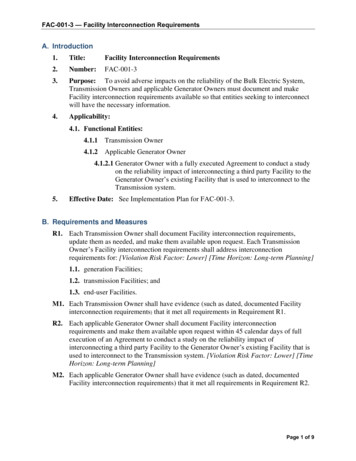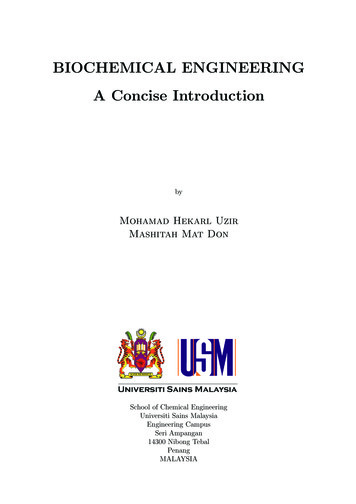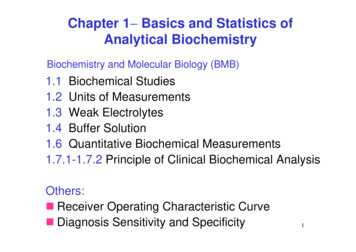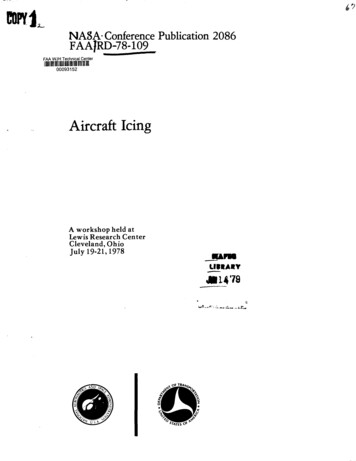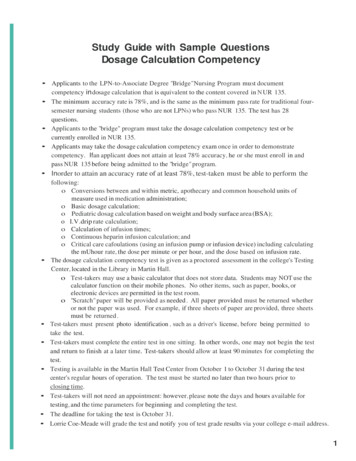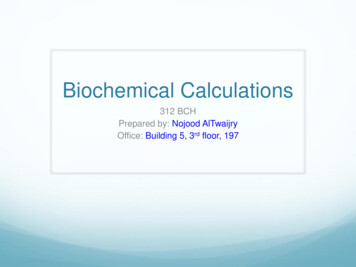
Transcription
Biochemical Calculations312 BCHPrepared by: Nojood AlTwaijryOffice: Building 5, 3rd floor, 197
Reference: Biochemical calculations by Irwin H. Segel.
Midterm dates 1st Midterm: 5th week, Monday 4th of February (28 Jumad’a I). Time 12-1 pm. 2nd Midterm: 10th week, Monday 11th of March (4 Rajab) Time 12-1 pm.
Marks distribution Midterm 1: 15 marks (15%) Midterm 2: 20 marks (20%) Lab: 25 marks (25%) Final exam: 40 marks (40%)
Objective of this lecture1) To be familiar with the names and type of glasswareused in the labs.2) To know how to calculate the molarity and normality ofsolutions
GlasswareBottlesWide neck, amber,bottles; can be usedfor a wide range oflight sensitive liquid orsolid storage.Reagent bottlesNarrow neck bottles;can be used for a widerange of liquid storage,media preparation andsampling applications.
Glassware continuedMedia-lab bottlesWash bottles
Glassware continuedBeakersConical shape beakers;ideally used for titrationsand mixing application,these conical shapebeakers are a crossbetween a standardbeaker and conical flask.Griffin beaker; isgreat for generallaboratory use.
Glassware continuedFlasksVolumetric flasks; areprecision measuringinstruments.Boiling flasksDistillation flasksErlenmeyerConical flasksCell culture flasks
Glassware continuedVolumetric wareBuretteBurette clampCylinderMixing cylinder
Glassware continuedTest tubesTest tubesTest tubeswith groundsocket joint.Culture TubesCentrifugeTubes
Glassware continuedPipettesOne mark pipetteType 1Type 2Graduated pipettesTwo mark pipettewith safety bulb attop.Pasteur Pipettes
Glassware continuedFunnelsFilter funnelsDropping &Separating FunnelsBuchner Funnels
Lab equipmentPetri dishesBalanceEvaporating dishesRing StandVial RacksTest Tube ClamppH meterTest Tube Rack
Lab equipment continuedPlatesMultichannel micropipettesMicropipettesTipsEppendorf tubes
Solution Composition A solute is the substance being dissolved. A solvent is the liquid in which the solute is dissolved. A solute is dissolved in a solvent. An aqueous solution has water as solvent.
Aqueous Solution The majority of reactions occur in solutions. There are several ways to express the concentration ofa substance in a solution based on: The volume The weight Degree of saturation
Concentration based on volume Here the concentrations are based on the amount ofdissolved solute per unit volume The calculations depending on volume include: Molarity (M)Normality (N)Activity (a)Weight/Volume percent (w/v %)Volume/volume percent (v/v%)Milligram percent (mg %)Osmolarity (osm)
1- Molarity Is the number of moles of solute per liter of solutionNo. of molesM Volume of solution in L No. of moles Wtg /MWT (molecular weight) 1 mole contains Avogadro’s number of molecules per liter(6.023 x 1023). Molar concentrations are usually given in square brackets Example: [H ] molarity of hydrogen ion[NaOH] molarity of Sodium Hydroxide
Molarity cont’ed Examples: A solution of NaCL had 0.8 moles of solute in 2 liters ofsolution. What is its molarity?no. of molesM volume of solution in LM 0.82M 0.4 molar
Molarity cont’ed Examples: How many grams of solid NaOH are required toprepared 500 ml of 0.04 M solution?M no. of molesvolume of solution in L500 ml 500 1000 0.5 Lno. of moles 0.04 0.5no. of moles 0.02 moleno. of moles weight in grammolecular weight (MWT)
Molarity cont’edMWT of NaOH 23 16 1 40Wt in grams no. of moles MWTwt in grams 0.02 40wt in grams 0.8 grams
2- Normality Is the number of equivalents of solute per liter of solutionN no. of equivalentsvolume of solution in Lno. of equivalents weight in gramEquivalent weight (EW)equivalent weight MWTnn is the number of replaceable hydrogen (H in acids)orhydroxyl ions (OH -in bases) per molecule
Normality cont’edn is the number of electrons gained or lost permolecule (in oxidizing or reducing agents)N N N no. of equivalentsvolume of solution in Lweight in gramEquivalent weightweight in gramMWT / n/volume of solution in L/ volume of solution in L
Normality cont’edN M M weight in gram n/volume of solution in LMWTno. of molesvolume of solution in Lweight in gram/ volume of solution in LMWTN n M For example: A 0.01 M solution of H2SO4 is 0.02N
Normality cont’ed Example: What is the normality of H2SO4 solution thatcontains 24.5 g of solute in a total volume of 100 ml? N n M n 2 M No. of moles / V(L) 100 ml 100 1000 0.1L No. of moles Wtg /MWT MWT of H2SO4 2 32 (16 4) 98g
Normality cont’ed No. of moles 24.5/ 98 No. of moles 0.25 mole M No. of moles / V(L) M 0.25/0.1 2.5 molar N n M N 2 2.5 5 normal
Normality cont’edAnother way to solve it: Normality (N) No. of equivalents / V(L) No. of equivalents Wtg of solute / equivalents weight (EW) EW MWT of solute / n MWT of H2SO4 2 32 (16 4) 98 g EW 98 / 2 49 No. of equivalents Wtg of solute / equivalents weight (EW) 24.5 g / 49 0.5 eq Normality (N) No. of equivalents / V(L) 0.5 / 0.1 5 Normal
1- Molarity Is the number of moles of solute per liter of solution M No. of moles Wt g /MWT (molecular weight) 1 mole contains Avogadro's number of molecules per liter (6.023 x 1023). Molar concentrations are usually given in square brackets Example: [H ] molarity of hydrogen ion [NaOH] molarity of Sodium Hydroxide No. of moles .


